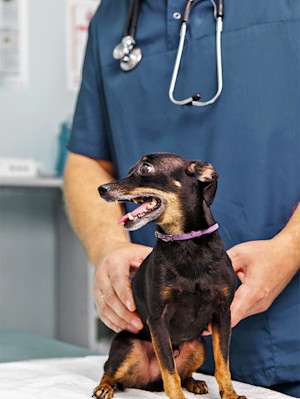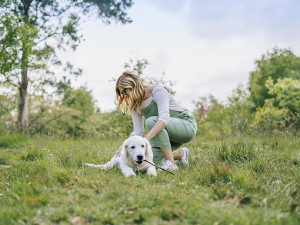Understanding Rabies: a Complete Guide For UK Pet Parents
Everything you need to know about the deadly disease

Share Article
In this article:
What is rabies? Rabies in the UK Rabies transmission Rabies symptoms Rabies prevention Emergency action Rabies survival rates FAQs
In June, a British woman tragically died from rabies after she was scratched by a puppy in Morocco in February.
Yvonne Ford, 59, from South Yorkshire, didn’t think anything of the scratch, guessing that no harm would come from it. But at the start of June, her family said she became very ill – a headache that resulted in her losing her ability to walk, talk, sleep or swallow. Two weeks later, she had died.
The sad caseopens in new tab is understandably scary for people to read. Could it happen to me, or to someone I love? Is it a risk I face in the UK? What can I do to protect myself, and my pets?
We’ve put together a guide of practical information and advice about the transmission of rabies that we hope will alleviate any fears you might have, and give you advice about what to do if you are exposed to it.
What is rabies and why should pet parents care?
Rabies (the RABV virus) is a zoonotic disease (meaning a disease that can be transmitted from animals to humans or from humans to animals).
“It’s the deadliest zoonotic disease in the world – once symptoms appear, it's fatal,” Dr Luke Gamble, a vet and CEO founder of the charity Worldwide Veterinary Serviceopens in new tab who launched Mission Rabiesopens in new tab, said. “It’s a neurotropic lyssavirus virus that affects the brain and nervous system and can be passed from animals to humans through saliva.”
Globally, over 99% of human rabies cases are transmitted via a bite from an infected dog.
“This is due to their close contact with people and low vaccination rates in many countries where rabies is present,” Emma Doughtyopens in new tab, infectious disease genomicist and epidemiologist, said.
Although rabies is entirely preventable, it kills at least 59,000 peopleopens in new tab every year around the world.
“Most of them are children,” Gamble said. “It is endemic in over 150 countries around the world. And the tragedy is that while the tools to eliminate it already exist, many parts of the world have limited access to those tools.”
However, there is evidenceopens in new tab that not all exposure to the rabies virus leads to the development of rabies disease and death.
Pet parents, especially dog owners, should know that by vaccinating their dog for rabies, they’re also protecting people.
“Vaccinating your pet doesn’t just protect them – it protects your family, your community and anyone they come into contact with,” Gamble said.
Rabies in the UK – current status and risks
In the UK, rabies has been eliminatedopens in new tab from animals living predominantly or entirely on land (terrestrial animals). The last rabid terrestrial animal in the UK was a quarantined puppyopens in new tab from Sri Lanka in 2008.
Since 1946, 26 cases of human rabies have been reported in the UK, all from imported animals. It’s been over a century since a case of human rabies was acquired from an animal in the UK.
Rabies-like viruses, called European bat lyssaviruses, have been shown affect bats in the UK, but these don’t impact the status of the UK as rabies-free. Rarely do these viruses cross from bats to humans, but they do cause clinical rabies in humans if and when they do. In 2002, a man who was a licensed bat handler died in Scotland from infection with EBLV-2opens in new tab, a rabies-like virus present in bats in the UK.
Pet parents bringing their dogs or cats into the UK from abroad are requiredopens in new tab to vaccinate against rabies. It’s crucial to follow the vaccination schedule to ensure the pet has booster shots when required.
The vaccine should be administered at least 21 days before entering the UK if coming from a Part 1 or Part 2 country (the EU and other specific third countries), and at least four months before entering the UK if coming from any other country.
How rabies spreads from animals to humans
Rabies is spread when infected saliva – usually through bites, scratches or direct contact with eyes, mouth or open wound – enters the human body.
Dogs are the main source globally – with 99% of the human rabies cases transmitted from dogs.
“But it can also be transmitted by cats, bats, foxes, raccoons and other mammals,” said Gamble.
Recognising rabies symptoms
Once the rabies virus enters the body of an animal, it travels along the nerves to the brain.
Early clinical signsopens in new tab of rabies include behaviour changes, a tendency to seek excessive attention and hypersensitivity to noise or light. This might be followed with increased aggression, staring, drooping jaw, itching and thirst. The final stages include weak muscles, difficulty swallowing, drooping eyelids, frothing at the mouth, paralysis, convulsions and finally, death.
But Doughty said animals could look “completely healthy” and still have rabies.
When rabies is transmitted to a human through the saliva of an infected animal, it moves very slowlyopens in new tab through the nerves into the central nervous system. Reaching the brain, it causes neurological symptoms, following by coma and death.
During the incubationopens in new tab phase, the virus can spend days to weeks in the human body before it gets into the nervous system. There aren’t any symptoms during this time. This is the only time treatment will work.
“The incubation period can last from weeks to months – sometimes (rarely) even a year,” said Gamble. “You could feel fine for a long time after a bite, even as the virus quietly travels through your nervous system. Once it reaches the brain and symptoms begin, it’s too late. That’s why immediate action is critical.”
In this phase, the virus replicates at the site of entry in muscle tissue and remains relatively silent, evading immune detection, according Doughty.
The ‘prodromal’ phase is next – when rabies travels into the brain and spinal cord. Trying to fight back, the immune system works hard, causing flu-like symptoms. By this phase, there is no treatment available.
During the acute neurologic phase, the rabies virus damages the brain and spinal cord. Two-thirds of people have ‘furious rabies’, with symptoms like aggression, seizures and delirium that last for a few days up to a week. Others have ‘paralytic rabies’, with weakness and paralysis progressing from the bite wound to the rest of their body, which can last up to a month.
“In people who become ill, the virus moves from neurone to neurone, often without triggering an inflammatory response, allowing it to reach the brain undetected,” said Doughty. “By the time the immune system recognises the infection, the virus is already established in the CNS, causing irreversible damage to neurones.”
Finally, coma is the stage that leads to death in an infected person.
Prevention and vaccination
Typically, dogs and cats should get their first rabies vaccination at 12 weeks old.
“Dogs and cats should then follow your local vet’s rabies vaccination schedule with regular boosters every three years,” said Gamble.
When travelling with pets, pet parents should ensure vaccinations are up to date and follow all travel requirements.
Unlike pets, people in the UK don’t get regular rabies vaccinations.
“Vaccination for humans isn’t practical,” Doughty said. “It’s costly, complex and still requires emergency treatment after exposure. The most effective way to stop rabies is by vaccinating dogs. It breaks the transmission chain at source.”
But if you are travelling to a part of the world where rabies is common, the NHS has recommended people get the rabies vaccination, pre-exposure prophylaxis which can be purchased and administered at health clinics and pharmacies with travel health services. However, it is worth noting that this doesn’t replace the need for treatment if you’ve been in contact with an infected animal – it just simplifiesopens in new tab rabies treatment and improves chances if treatment is delayed or incomplete.
Post-exposure prophylaxis is the emergency response to a rabies exposure to prevent the virus getting into the central nervous system. It might consist of (depending on the extend of exposure) extensive wound washing with water and soap for at least 15 minutes after exposure, a course of rabies vaccine and administration of rabies immunoglobulin or monoclonal antibodies into the wound.
“Mortality rate is close to zero percent when timely post-exposure prophylaxis is administered before symptoms begin,” said Doughty.
If you aren’t able to get immediate treatment, Doughty would still urge you to seek treatment.
“Whilst rabies treatment should ideally be started as soon as possible, given the potentially long incubation period for rabies it is still worthwhile to start treatment even when the potential exposure was days, weeks or even months ago.”
What to do if you're bitten by an animal abroad
If you’re bitten by an animal abroad, or you suspect you’ve come into contact with an animal with rabies, you should immediately wash the wound with soap and running water for at least 15 minutes, applying antiseptic if available.
“Then seek medical help immediately,” said Gamble. “Even a minor scratch should be taken seriously in rabies-endemic countries.”
Finally, begin post-exposure prophylaxis as soon as possible. The measures taken in post-exposure prophylaxis depends on the severity of exposure.
“This includes a series of vaccines – and in severe cases (if the bite victim hasn’t ever been vaccinated), a dose of rabies immunoglobulin (antibodies),” said Gamble.
Doughty also suggested documenting treatment including product names, doses, batch numbers and dates of administration.
“These records will be important if you need to continue the vaccine course elsewhere or at home,” Doughty said.
The reality of rabies survival
“Sadly, rabies is considered 100% fatal once symptoms appear,” said Gamble. “It attacks the nervous system and brain, leading to a painful and distressing death. Only a handful of people in history have survived without prior vaccination, and even then, under extremely rare circumstances – they have also never fully recovered. There is no cure. That’s why prevention is everything.”
There are few documented survivors, despite the bleak survival rates. Doughty said reasons for this are varied. They might have managed to mount a rapid, robust immune response before the infection reached or damaged the immune system, had detectable rabies virus-neutralising antibodies, or had a weaker variant of the virus.
Jeanna Giese survived the virusopens in new tab in 2008 after receiving a treatment that became known at the Milwaukee Protocol. Doctors put Jeanna into an induced coma to give her own immune system time to build up antibodies to fight the virus. They also gave her antivirals ribavarin and amantadine. After waking her, they gave her six months of a compound called tetrahydrobiopterin. And she survived.
At least 34 other casesopens in new tab of people survived rabies after symptoms onset using the Milwaukee Protocol, but there have been at least 64 cases where the protocol failed.
In India, where rabies continues to be a serious public health problem, a studyopens in new tab outlined the survival of eight patients who were treated with intensive care.
But this study concluded stating: “The primary focus should be on the prevention of rabies by increasing awareness about the disease and post-exposure prophylaxis protocols among the public and health-care professionals in rabies-endemic countries.”
Frequently asked questions
Can someone survive rabies?
Although there have been a minute number of survivors of rabies, the virus is 100% fatal once the virus infects the central nervous system and clinical symptoms appear.
“Once symptoms appear, rabies is almost always fatal,” said Doughty. “But if treated early with post-exposure vaccination, it’s entirely preventable.”
How long can a person survive with rabies?
The time a person can survive with rabies depends on how quickly the virus moves through the body. A person goes through four phases: incubation (lasting days to weeks), prodromal (two to ten days), acute neurologic (a few days to a month), and coma.
What happens if a person gets rabies?
If a person suspects they have been exposed to rabies, they should wash the wound with soap and water for 15 minutes, and then immediately see a healthcare provider for treatment, which may include vaccinations and an antibody treatment.
Is rabies still 100 percent fatal?
Yes, once rabies gets to a person’s central nervous system, and symptoms are present, the virus is 100 percent fatal.
Why don't humans get rabies shots routinely?
As the UK is ‘rabies free’, routine rabies shots/vaccines are not regularly administered by the NHS. The vaccination is only recommended for people at risk of getting rabies, including people travelling abroad and people at risk through their work.
Has anyone survived rabies without a vaccine?
Yes, there have been less than 20 documented casesopens in new tab of human survival from clinical rabies. Only a few of these survivors had no history of rabies vaccination before disease onset.
Why do rabies patients fear water?
Hydrophobia (fear of water) is a clinical sign of human rabies, following paroxysmalopens in new tab contractions of pharynx responsible for hydrophobic spasms. Hydrophobia prevents sufferers of rabies from hydrating efficiently, dwindling the water content of saliva. With less water in the salivaopens in new tab, rabies’ concentrations soar.
“It’s not psychological,” Gamble said. “The virus causes painful spasms in the throat and larynx when the person tries to swallow, making it feel impossible to drink. It’s harrowing to witness and even more reason to ensure no one ever reaches that stage.”
Can rabies be cured once symptoms appear?
No, once symptoms appear, rabies cannot be cured – it is 100 percent fatal.
If people want to help fight rabies, Mission Rabies are always looking for volunteers for their mass vaccination campaigns! They vaccinated 230,000 dogs in 12 days last year in Cambodia and had over 200 volunteers join them. If anyone wants an adventure, (and they love dogs) then come to Cambodia in Octoberopens in new tab! To find out more about the charityopens in new tab check out @lukegamblevetopens in new tab.
References
Jones, Steve. “Briton Dies from Rabies after ‘Scratch’ from Stray Puppy in Moroccoopens in new tab.” BBC News, 18 June 2025.
Hemachudha, Thiravat, et al. “Human Rabies: A Disease of Complex Neuropathogenetic Mechanisms and Diagnostic Challengesopens in new tab.” The Lancet Neurology, vol. 1, no. 2, June 2002, pp. 101–9.
Public Health England. “Rabies: Epidemiology, Transmission and Prevention.opens in new tab” GOV.UK, 2 Nov. 2018.
“Bringing Your Pet Dog, Cat or Ferret to Great Britainopens in new tab.” GOV.UK, 2023.
Scott, Kirsty. “Man Dies from Rabies after Being Bitten by Bat.opens in new tab” The Guardian, The Guardian, 25 Nov. 2002. Accessed 9 July 2025.
Lite, Jordan. “Medical Mystery: Only One Person Has Survived Rabies without Vaccine--but How?opens in new tab” Scientific American, 8 Oct. 2008.
Jackson, Alan C. “Demise of the Milwaukee Protocol for Rabiesopens in new tab.” PubMed, National Institutes of Health, Mar. 2025.
Mani, Reeta S., et al. “Case Reports: Survival from Rabies: Case Series from Indiaopens in new tab.” The American Journal of Tropical Medicine and Hygiene, vol. 100, no. 1, Jan. 2019, pp. 165–69.

Lauren Crosby Medlicott
Lauren is a freelance journalist who lives with her family and black labrador, Betsie, in the south Wales valleys. When she’s not working, she loves going for a dip in a nearby river and hiking in the Brecon Beacons.
Related articles
![man and lab puppy on park road]()
When, Exactly, Should You Vaccinate Your Puppy?
If it’s time for their jabs, follow this guide
![woman on a beach in greece petting a stray dog]()
Is It Safe to Stroke Stray Dogs On Holiday? Everything You Need to Consider
Before you pet that stray dog on your holiday, find out how to protect yourself and still show compassion
![a vet's hand hold a small black and tan dog on a bed in the vet office]()
Are Yearly Dog Vaccinations Really Necessary in the UK?
Doggy admin may be tough, but it’s important
![black and white dog looking ill laying on couch]()
Warning Signs Your Dog Needs to Go to the Hospital – Right Away
Trust me, I’m a vet
![A woman checking her dog for ticks outside in a grassy field.]()
Lyme Disease in Dogs: What Every Dog Parent Should Know
We asked a vet for tips on how to prevent the tick-borne Lyme disease in dogs





